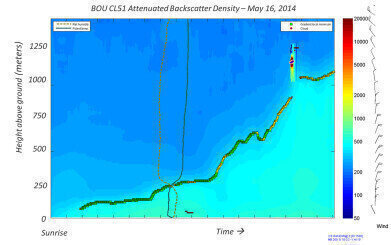-
 The four-year airborne NASA campaign aims to measure pollution near the Earth's surface.
The four-year airborne NASA campaign aims to measure pollution near the Earth's surface.
Air Monitoring
Local Support for NASA Pollution Field Campaign over Colorado
Jul 14 2014
Vaisala's (Finland) Boulder office is supporting field campaigns beginning this month in Colorado that will probe the factors leading to unhealthy air quality conditions and improve the ability to diagnose air quality conditions from space. DISCOVER-AQ, which stands for Deriving Information on Surface conditions from Column and Vertically Resolved Observations Relevant to Air Quality, is a four-year airborne NASA campaign that is studying techniques to measure pollution near the Earth's surface.
Multiple federal agencies and research institutes are participating in the program, and in Colorado, the campaign includes close collaboration with the state of Colorado and the NSF sponsored, FRAPPÉ (Front Range Air Pollution and Photochemistry Experiment). Vaisala is extremely proud to be associated with this major air quality study, and to have its equipment selected to be part of the suite of instruments used in the study.
In addition, Millersville University will be utilizing Vaisala RS41 radiosondes for the campaign. Millersville University has recently upgraded from its RS92-SGP to the new RS41 system in time for its deployment in Colorado as part of the DISCOVER-AQ project. Dr. Richard Clark, Millersville researcher, has been using Vaisala radiosondes for boundary layer research since 1991.
Vaisala has also installed a further CL51 ceilometer on the roof of its Boulder office in support of the project. Vaisala's Boulder office is positioned close to the middle of the flight paths planned by the NASA aircraft used for air quality sampling.
As the CL51 ceilometer sends energy up into the atmosphere, small particles including pollutants and aerosols will scatter some of that energy back to the surface. This energy is referred to as backscatter data and is displayed in the attached image in a three hour long time vs. height graph. An algorithm designed to look for sharp changes in backscatter data is applied to detect atmospheric structures that make up the planetary boundary layer. The image shows a vertical profile from the Vaisala Boulder office CL51 that has been overlaid with data from an RS41 radiosonde flight, and shows the near identical detection of the atmospheric structures. The CL51's ability to detect these structures is directly related to the concentration of aerosols making it a valuable input for air quality monitoring and forecasting.
"Colorado's steady population growth, coupled with the unique weather patterns found on the eastern slope of the Rocky Mountains, often creates challenges to air quality in the region" states Scott Sternberg, President of Vaisala Inc. "We are proud to support this study where a deeper understanding of atmospheric conditions could lead to a better quality of life for all Front Range residents."
Digital Edition
IET 34.2 March 2024
April 2024
Gas Detection - Biogas batch fermentation system for laboratory use with automatic gas analysis in real time Water/Wastewater - Upcycling sensors for sustainable nature management - Prist...
View all digital editions
Events
Apr 30 2024 Melbourne, Australia
Apr 30 2024 Birmingham, UK
May 03 2024 Seoul, South Korea
May 05 2024 Seville, Spain
May 06 2024 Minneapolis, MN, USA

















